If we’ve learned anything from the last decade of action movies, it’s that the genre survives on reinventions of silence—moody loners, voiceless avengers, and, now, a deaf cop lumbering through another hour of plot-optional philosophy about justice in America. Brad Anderson’s “The Silent Hour” arrives with a grandiose hush, promising that, if we just listen hard enough, we’ll hear something new. But what we get is less revelation and more the faint clatter of old clichés, recycled under the guise of representation.
Joel Kinnaman is back, gritting his teeth through another disability—last Christmas, he lost his voice; this year, as Frank, he’s lost his hearing. There’s a vaudevillian sense of progression here: next time, maybe he’ll lose his sense of smell and sniff out crime. But if “Silent Night” at least played with the joke of voiceless rage (there’s something genuinely subversive in refusing to let an action hero speak), “The Silent Hour” approaches deafness with a kind of earnest checklisting. There’s sign language. There’s awareness. But there’s no pulse.
The plot? Or should I say, the motions. Boston, bathed in the customary sodium-vapor gloom, and Kinnaman’s Frank—newly deaf—must protect Ava (Sandra Mae Frank), a deaf witness to a gangland murder. The set-up is a ballad of peril, but the execution wanders like a rookie cop on his first beat, unsure of which way to look for trouble. I wish I could say the layers of disability add genuine intrigue, but they’re more like tissue paper masking the gifts we’ve all unwrapped before—dirty cops, bad guys, stock suspense. It’s cat-and-mouse, but the mouse is dozing off mid-chase.
Every so often, someone (probably hopped up on “The Raid” and fond memories of John Woo’s balletic shootouts) decides the modern thriller needs to move. Here, though, the action doesn’t run so much as slouch. The standoffs should be crackling—the kind where you can feel the sweat popping off everyone’s brow—but Anderson lets them drag, stripping away tension until all that’s left is inevitability. We’re not riding a kinetic train, we’re trapped in a stationary car, listening to the engine idle and wondering if the driver fell asleep at the wheel.
Is it clever to make Frank deaf? It could be—a director with a little nerve might explore what violence sounds like when the noise drops out, when menace comes in the thrum of boots on a rooftop or the vibration of a body hitting the floor. But Anderson moves through the potential like a shopper on Christmas Eve, checking items off without ever really feeling them. Deafness is there, dutifully referenced, but never essential. It’s just one more prop, like the inevitable Christmas tree in a Hallmark movie—present, yes; transformative, not a chance.
Would the plot shock you? Only if you’ve spent your life quarantined from narrative convention. Every “twist” is telegraphed in block letters; the dirty cop isn’t just dirty, he’s practically flagged by the subtitles. The sign language and the nods to deaf culture could have provided new rhythms, fresh wrinkles—moments of real communication and miscommunication that throw genre expectations into chaos. Instead, they’re slathered onto the same crusty loaf. It’s as if the filmmakers saw an opportunity for challenge and retreated into the familiar, as if scared off by their own premise.
And oh, the pacing. In an age where everyone’s addicted to speed and spectacle, “The Silent Hour” moves like molasses in January. The scenes that should ignite—Frank and Ava cornered by killers, backs against the icy city, exchanging glances no one else can quite read—are left to linger, draining away suspense. By the time the obligatory climactic shootout arrives, the audience is ready to shoot itself out of the theater just to get some movement. Anderson could have let the knife twist, but he’s too gentle, more interested in holding your hand than slapping your senses awake.
There’s an odd, accidental tradition forming here: Kinnaman, the action hero whose disability is always serenaded by Christmas lights. Is he our new patron saint of yule-tide violence—the next Bruce Willis, minus the wit or the glimmer of insanity? I kept hoping, in lieu of snappy one-liners and holiday hijinks, that someone would let slip a “yippee-ki-yay.” Instead, we get mute suffering and morality plays in snow-choked alleys. “Die Hard” deconstructed the genre by making its hero bleed and laugh. “The Silent Hour,” by contrast, just makes him tired—and us, too.
In the end, “The Silent Hour” is the action-thriller equivalent of a department store Christmas sweater: looks good at first, but after ten minutes you’re itching to take it off and move on to eggnog. Maybe next year Kinnaman can don a different impairment—blindness, perhaps—“Jingle Blinds” or “Frosty the Blind Snowman.” Why not? At least it might lead to a plot twist that cuts through the formula. Imagine: our hero, flailing his way through the baddies, accidentally saves Christmas by bumping into the villain’s hideout. Now there’s a silent night I’d buy a ticket to.
Final Take: I wanted electricity; all I got was static.


